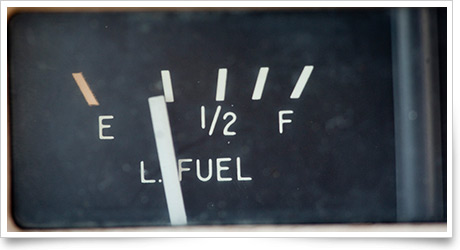training tipsLow clouds, lower fuel
As you fly along at low altitude beneath the supposedly reduced ceiling that your instructor has imposed, the nice visual checkpoints visible from higher have vanished, and up ahead, terrain rises.
There’s another problem: fuel (that is, time). Your cross-country flight was in progress for about three hours when the lost-procedures exercise commenced. Now you wish you had refueled on landing at the destination.
Under today’s conditions, your 1978 Cessna 172 burns 6.4 gallons per hour, which you prudently rounded off to 7 gph for flight planning. You departed on the flight with 40 gallons of usable fuel, which you adjusted down by 3.5 gallons to 36.5 gallons to exclude the required 30-minute day VFR reserve. Now you have about 15.5 gallons left, not including reserves. Wait— after two takeoffs and climbs, it may only be 12.5 gallons. (The thought now occurs to you that next time, you will schedule the FBO’s other airplane for cross-countries—the aircraft with long-range tanks.)
In any case, next time you also will hold yourself to a stricter standard for how much fuel to carry. That policy would have led you to wait for the fuel truck driver to return from lunch after you landed at the destination, as this Fuel Awareness Safety Advisor from the Air Safety Institute recommends: “Give yourself an hour’s reserve—the FAA requires a 30-minute fuel reserve for day VFR flights, and a 45-minute reserve for IFR and night VFR flights. Think of these requirements as minimums. ASI recommends that you always land with at least an hour’s fuel in reserve.”
Although extra gas would buy you more time to deal with the problem of being lost, it won’t change the fact that if the “weather” worsens, or the terrain becomes more inhospitable—or both—you may have to contemplate a precautionary landing at the next good opportunity.
Indeed, now your instructor announces solemnly that you will penetrate clouds unless you make an immediate (but gentle and standard-rate) left turn. You comply, and on the rollout you behold the home airport, straight ahead.
That's another lesson: Even the familiar environs of the home field can seem unrecognizable to a pilot fixated or distracted by flying under pressure. training productsRevised private pilot syllabus releasedASA has released the fifth edition of The Pilot’s Manual: Private Pilot Syllabus . A flight and ground training course for the private pilot certificate, this syllabus meets all FAA Part 141 and 61 requirements. Flight lessons are presented side-by-side with coordinating ground lessons. The syllabus includes stage exams and a basic ATD syllabus in the appendix. The cost is $12.95. Online course teaches ground safetyPC Aviator is offering the Windows-based interactive course Getting Around on the Ground 3.0 With Airport Simulator . This multimedia tool teaches the types of airport markings, signage, and lighting. It also outlines hazards, safety tips, and procedures that will help keep students aware, knowledgeable, and safe on the ground. The cost is $99.
Note: Products listed have not been evaluated by ePilot editors unless otherwise noted. AOPA assumes no responsibility for products or services listed or for claims or actions by manufacturers or vendors. final examQuestion: Who can legally declare an emergency with air traffic control?
Answer: The pilot, air traffic control facility personnel, or officials responsible for the operation of the aircraft can declare an emergency, according to FAA Order 7110.65 section 10-2-5. Chapter 10, Emergencies, contains operational rules from an air traffic controller’s point of view. This is a beneficial document to browse from time to time to see the “bigger picture” with regard to your flight operation. Chapter 6, Section 1 of the Aeronautical Information Manual discusses when a pilot should declare an emergency.
Got a question for our technical services staff? Email [email protected] or call the Pilot Information Center, 800/872-2672. Don’t forget the online archive of “Final Exam” questions and answers, searchable by keyword or topic. |
 You’re lost. Fortunately the person sitting next to you isn’t, because this is trying enough, even as a drill.
You’re lost. Fortunately the person sitting next to you isn’t, because this is trying enough, even as a drill.

